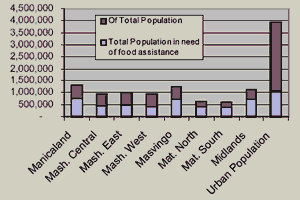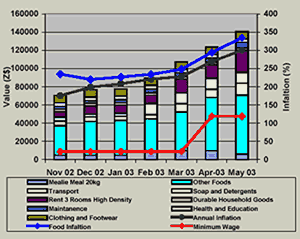|
Back to Index
Zimbabwe
Humanitarian Situation Report
The
UN Humanitarian Co-ordinator’s Bi-Monthly Report No 12/03
June 23, 2003
FAO/WFP Crop
and Food Supply Assessment results launched
The
report of the FAO/WFP Crop and Food Supply Assessment (CFSAM) was
launched on 20 June 2003. The report outlines the results of the
assessment that took place in April 2003, covering 24 districts
in all provinces of Zimbabwe. Field assessments were made regarding
household food security, vulnerability, coping mechanisms and social
welfare programmes.
The CFSAM results
indicate that close to 5.5 million people will be in need of food
assistance in 2003/04, 4.4 million people in rural and 1.1 million
in urban areas as outlined below. However, apart from urban areas,
not all the affected people will be in need of full-year support.
In response
to this situation GoZ will have to import approximately 370,000MT
of maize (part of this will be made up of a quantity of some 174,000MT
of maize that has already been purchased but not yet received).
In addition it has been assumed that deficits in wheat and rice
of 298,000 and 9,000MT respectively, will be met by commercial imports.
The remaining gap, all in terms of maize should be covered by food
aid. The total emergency food aid requirement has been estimated
to total 610,000MT of maize where the total cereal requirement is
currently 1.287 million MT. Of the total requirement only 120,000MT
is currently in the pipeline, the remaining 490,000MT will have
to be met by new contributions.
Estimates for
this assessment were based on population figures from the 2002 census
and a projection of this figure for mid 2003. This gave a total
population of close to 11.7 million people in Zimbabwe.
Estimates
of affected population

In terms of
proportion of population in need of assistance, Matebeleland North
and South and Midlands are the provinces most in need, with 67%,
61% and 63% of their populations in need respectively. In absolute
figures Manicaland is estimated to have the highest number of people
(757,809) in need of assistance.
While this year's
cereal production for consumption is expected to be better than
last year’s very poor harvest (up 41%), it is still well below average
(51% lower than the 2000/01 harvest) and well below requirements.
This food security outcome is a result of a number of factors including:
- Erratic rainfall
and dry spells, which meant that farmers had to replant many times
as previous plantings were largely lost because of the drought.
- Severe shortages
of maize seed and fertilizer at planting time. This was made worse
by the need to plant two or three times in many cases because
of successive crop failures.
- The closure
of commercial farms.
- Continuing
constraints caused by the shortage of foreign exchange, affecting
a number of key sectors of the economy.
- Lack of training
in proper crop husbandry especially for newly resettled farmers
The CFSAM also
estimated a much lower than average winter crop of wheat. Wheat
production is lower because of shortages of fertilizer and poor
irrigation infrastructure as well as changes in the commercial sector.
The mission
has recommended that food assistance is phased throughout 2003/04.
In addition to the 5.4 million people described above, there are
also a substantial number of people in Zimbabwe who will need other
forms of assistance other than direct food aid. These people now
have the resources to buy food when it is available on the market,
but they are rapidly using up their income and savings buying high-priced
food, and will eventually need food aid if major new supplies of
food do not enter the market soon and moderate prices. This population’s
food crisis can best be resolved with food imports for the market,
not food aid. If their needs are not soon served, the food crisis
will become much larger and more difficult to resolve.
Preparations
for the Urban Vulnerability assessment underway
ZimVAC
are currently in the process of leading the preparations for an
urban vulnerability assessment to complement the soon to be completed
rural vulnerability assessment. Food security within the urban and
peri-urban areas continues to be an issue of major concern due to
the rapidly declining economy. Like the rural vulnerability assessment,
the process will involve key UN Agencies and NGOs.
The urban population
in Zimbabwe has nearly tripled since independence, from an estimated
1.6 million in 1982 to almost 4.2 million in 2002. At present some
36% of the population live in urban areas. Indications are that
the deterioration of economic and social conditions have had a significant
impact on urban populations. The 1995/96 UNDP sponsored Poverty
Assessment Study Survey (PASS) estimated that 39% of those living
in urban areas were poor, while 1999 estimates indicate that the
figure jumped to 60%.
Urban vulnerability
assessments were carried out in 2001 and 2002 in Harare and Bulawayo
respectively. Since this time there have been significant economic
and social changes in Zimbabwe and it is even more important now
to understand and monitor people’s vulnerability to these changing
circumstances. Both the FAO/WFP and ZimVAC assessments have outlined
the importance of carrying out this exercise. The FAO/WFP CFSAM
has estimated that 1.1 million people living in urban areas will
be in need of food assistance throughout 2003/04 and that monthly
food aid needs would remain constant throughout the year. The CFSAM
Mission observed that the situation in urban and peri-urban areas
has deteriorated mainly due to hyper-inflation and unemployment.
The Consumer
Council of Zimbabwe (CCZ) have released updated commodity price
figures as shown in the graph below. The food inflation rate is
pegged at 334.6 per cent, and this has been driven by the annual
inflation rate which is at 300.1 per cent as in May 2003.
The proposed
assessment will add value to existing initiatives in Zimbabwe by
filling gaps in information and analysis.
In addition,
discussions are underway to strengthen the role of the existing
Urban Vulnerability Working Group such that it encompasses both
assessment and programme discussion and decision-making. The next
Urban Vulnerability Working Group is taking place on 8th
July 2003.
Commodity
prices/Food Inflation

Summary of
Nutrition Survey results presented
A
summary of the national nutrition survey results has been presented
to key humanitarian stakeholders. The survey was done in, February
2003 by the Ministry of Health and Child Welfare, UNICEF, WHO, WFP
and some NGOs with funding from DFID. The results show that the
national nutrition situation has deteriorated through 2003 and that
those districts that initially had lower prevalence have deteriorated
the most.
The national
survey sampled 50,000 children from across Zimbabwe. The main objectives
were:
- To measure
nutritional status of children 6-59 months
- To estimate
crude mortality rates
- To assess
coverage of child supplementary feeding programmes
- EPI
The summary
states that nationally, global acute malnutrition (GAM) stands at
5%. District level prevalence rates ranged from 2.8% in Umzingwane
to 10.7% in Mutare. GAM prevalence rates of above 8% are occurring
in four districts; Binga 8.8%, Gokwe North 9.8%, Mutare 10.7% and
Mutasa 9.8%. Another 11 districts have prevalence rates above 6%.
The national
level of severe malnutrition is 1.4%. This represents a high proportion
of GAM. 25% of districts nationally (15 in total) have severe acute
malnutrition (SAM) equal or above 2%, this is significant and alarming,
particularly as Zimbabwe does not currently have the capacity to
deal with the caseload. The distribution of these districts is shown
below.
The districts
concerned are, Mutare, Mutasa, Guruve, Shamva, Mazowe, Hwedza, Mudzi,
Marondera, Shurugwi, Zvimba, Gokwe North, Nkayi, Kwekwe, Mberengwa
and Gwanda.
Underweight
prevalence
Almost
all the rural areas, expect Masvingo, have an underweight prevalence
above the national average of 17.2%. Underweight in urban centres
remains well below the national average. It is important to note
that the rural provinces showing deterioration had much higher HIV/AIDS
prevalence than other provinces.
C-SAFE
assessment commences
At
the specific request of USAID, UN/RRU is assessing the impact of
the community assistance programmes funded under the Consortium
for Southern Africa Food Security Emergency (C-SAFE). C-SAFE Zimbabwe
is being implemented by the NGOs, CARE Catholic Relief Service and
World Vision, with the latter tasked for national co-ordination
activities. UN/RRU will provide USAID, the funding agent, an independent
assessment of the programme’s functioning. The assessment will look
at targeting issues, monitoring activities, delivery effectiveness
and community reactions to the programme. The assessment will take
place from 24 June to 15 July in those provinces that have active
C-SAFE programmes, Matebeleland South, Matebeleland North, Masvingo,
Midlands and Mashonaland West.
UNDP sponsors
HIV/AIDS workshop for GoZ Ministries
Members
of 12 GoZ ministries have participated in a workshop linking HIV/AIDS
interventions to macro-economic frameworks, sectoral policies and
the establishment of HIV/AIDS workplace friendly programmes. This
workshop was held in Kadoma from 17-21 June 2003.
The UNDP sponsored
workshop was held in order to assist GoZ ministries and other participants
to:
- Identify
the factors which spread HIV;
- Understand
the multi-faceted nature of AIDS and its impact on development
including factors such as poverty gender inequality;
- Exchange
methods, tools and approaches for formulating sector plans, policies,
programmes and strategies that might reduce the spread of HIV
and its negative impact.
The participants
were taken through steps of application of strategic and systems
thinking as tools for reflecting HIV/AIDS in development instruments
and sectors. This process helped to bring about an understanding
of why current responses to HIV have to be accelerated and expanded.
Participants were also able to identify vulnerable groups within
their sectors and to develop appropriate responses. Frameworks for
sector plans were the outputs of the workshop.
Displacement
in Ruwa
The
UN/RRU has undertaken a rapid assessment in, Ruwa District to review
the humanitarian needs of a population that had become displaced
from their homes. The assessment found that 92 farm workers families
(460 people) had been temporarily displaced from their homes. Some
assistance has already been offered to the displaced people and
UN/RRU is following up to ensure that the humanitarian needs of
the affected populations are met.
Do-No-Harm
in aid programming seminar
The
Embassy of Sweden in collaboration with the International Federation
of Red Cross and Red Crescent societies (IFRC) held a half-day seminar
on aid programming. Entitled ‘Do-no-harm and options for better
aid programming in conflict situation’, the seminar, held on 19
June 2003, outlined an initiative that is based on 15 field based
case studies from around the world that show clear patterns about
how aid interacts with local tensions in both negative and positive
ways.
The Do-No-Harm
approach shows how well planned aid programming
can support local capacities for recovery and reconciliation in
communities affected by conflict and violence.
Information
Reference of Humanitarian Assistance Meetings - June 2003
NB: Meetings
are by invitation only. Please contact the focal point person if
you wish information about any of these meetings
- 26th
June ‘03 HC monthly
humanitarian meeting with NGOs: Contact: Annika Rosing, UNDP.
- 26th
June ‘03 Food Aid
Donors Meeting Contact: Makena Walker, WFP.
- 26th
June ‘03 Emergency
Agricultural Recovery Co-ordination mtg Contact: Morris Mudiwa,
FAO.
- 2nd
July ‘03 Education
WG Contact: Carla Rosa-Borges, UNICEF.
- 8th
July ‘03 Urban Vulnerability
WG Contact: Elliot Vhurumku, FEWS NET
- 17th
July Child Protection
WG Contact: Mayke Huijbregts, UNICEF.
For additional
information or comments, please contact the United Nations Relief
and Recovery Unit, Harare Tel: +263 4 792681, ext. 207 or e-mail:
rru.zw@undp.org
This Situation
Report can be accessed on the Web at: www.reliefweb.int
then click on "by country", then click on "Zimbabwe"
Please credit www.kubatana.net if you make use of material from this website.
This work is licensed under a Creative Commons License unless stated otherwise.
TOP
|

